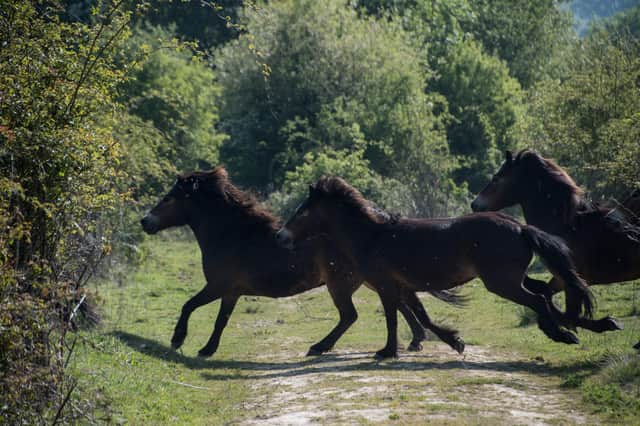Exploring Knepp’s wildlife with the rewilding estate’s safari guide


I am sitting a little distance away, binoculars trained upon a large herd of wild ponies against a low August sunset.
The two youngest foals canter around the herd, their tiny hooves making a gentle drum beat on the hardened clay. The mares graze on, showing no interest in their antics. It is exhilarating to watch.
Advertisement
Hide AdAdvertisement
Hide AdWe’re familiar with domesticated horses and ponies in the Sussex countryside but free-roaming herds are not an ordinary sight.
Our ancestors, though, would have lived in a landscape traversed by super-herds of the European wild horse – a creature we hunted to extinction in Britain.
The Exmoor ponies I’m watching now, in the 3,500-acre rewilding project at Knepp Estate near Horsham, are an ancient indigenous breed. They have a remarkable resemblance to their wild ancestor: large, toad-like eyes with padded eyebrows and a double coat which insulates them against cold weather and rain. Their brown coats contrast against pale markings on their flanks, muzzles and stomach. These ponies belong to a suite of animals introduced as proxies for the large herds that would have once wandered the British landscape in vast numbers.
Cattle, pigs and three species of deer also roam here, their browsing, grazing, puddling and rootling helping shape a dynamic mosaic of continually changing habitats, providing the conditions with which our native flora and other fauna have evolved.
Advertisement
Hide AdAdvertisement
Hide AdI started working as a safari guide for Knepp in 2017 and it wasn’t long before my love of horses drew me to focus on these wild pony herds. With free rein to choose their favoured grazing and drinking places, and areas where they like to shelter from wind, rain and sun, I watch them create micro-habitats – trails of compacted soil (where solitary bees like to drill their nesting holes) and shallow puddles under low-lying branches where they like to scratch their backs.
Stallions generate dung heaps or ‘latrines’ as territorial markers, intensifying soil fertility in their favourite spots, the organic dung itself attracting a proliferation of dung beetles such as the violet dor beetle – a beetle that, until Knepp’s rewilding experiment, hadn’t been seen in Sussex for 50 years.
I watch white storks carry the dung to line their nests, and swallows swooping down daringly to hoof level to catch horseflies on the wing.
With their powerful top and bottom incisor teeth the ponies can bite off even the toughest grasses, thistles, rushes and thorny scrub, and their unique digestive system helps them break down the fibrous stems in their gut.
Advertisement
Hide AdAdvertisement
Hide AdBrowsing and grazing in this way – so different to the way cattle eat – helps create a mosaic of taller, rough vegetation and shorter cropped lawns.
Their ability to transfer seeds via their guts, hooves, manes and coats helps to move flora around the landscape. Like zebra and wildebeest on the plains of Africa the different feeding strategies of horses and cattle complement each other and may even help reduce parasites.
Today, Knepp’s savanna-like terrain, driven by the actions of the Exmoors and the other large herbivores, is a dynamic, complex, continually evolving ecosystem that has become a magnet for wildlife – including many rare species such as nightingales, purple emperor butterflies, peregrine falcons, hedgehogs and critically endangered turtle doves and bats. As we look to the future, I envisage a landscape where horses are once more galloping free, playing their part in restoring wildlife across the country, in our rugged uplands and our lowland savannahs, splashing across rivers, their presence bringing renewed life to us all.
Comment Guidelines
National World encourages reader discussion on our stories. User feedback, insights and back-and-forth exchanges add a rich layer of context to reporting. Please review our Community Guidelines before commenting.